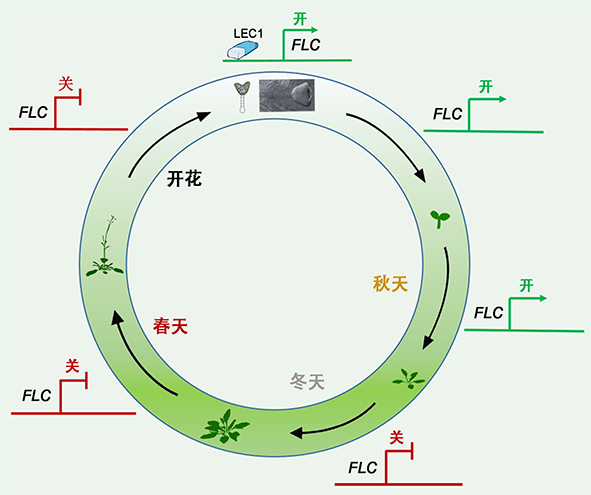“先驱”转录因子LEC1在早期胚胎重置春化状态的机制
- 许淑娟 ,
- 种康
- 1中国科学院植物研究所, 植物分子生理学重点实验室, 北京 100093
2中国科学院大学, 北京 100049
收稿日期: 2017-12-04
录用日期: 2018-01-10
网络出版日期: 2018-01-10
Mechanism of The “Pioneer” Transcription Factor LEC1 in Resetting Vernalized State in Early Embryos
- Xu Shujuan ,
- Chong Kang
- 1Key Laboratory of Plant Molecular Physiology, Institute of Botany, Chinese Academy of Sciences, Beijing 100093, China
2University of the Chinese Academy of Sciences, Beijing 100049, China
Received date: 2017-12-04
Accepted date: 2018-01-10
Online published: 2018-01-10
摘要
开花是植物由营养生长阶段向生殖生长阶段转变的重要过程, 长时间低温处理即春化对开花起到非常重要的促进作用。春化控制的拟南芥(Arabidopsis thaliana)开花中, 阻抑型转录因子FLC是重要的关节点, 春化记忆依赖于对该基因的控制。何跃辉研究组之前对拟南芥的研究揭示了转录因子VAL1或VAL2可以识别负调控开花的关键基因FLC成核区的顺式DNA元件, 协同PRC2复合体在春化过程中沉默FLC基因的表达, 并在随后的常温下继续维持FLC基因沉默直至受精结束, 使植物产生春化记忆。但在下一代中如何擦除这种记忆功能, 使FLC重新被激活, 以防止植物在过冬前或过冬时开花, 相关机制目前并不清楚。近期, 该研究组揭示了在植物胚胎发育早期一个种子特有的“先驱”转录因子参与擦除春化记忆, 重新激活FLC基因的分子机制, 并解析了胚胎中的基因激活传递到后胚胎发育(营养生长期)的表观遗传机理。该研究是开花领域的重要突破, 为作物开花调控的生产应用提供了新思路。

本文引用格式
许淑娟 , 种康 . “先驱”转录因子LEC1在早期胚胎重置春化状态的机制[J]. 植物学报, 2018 , 53(1) : 1 -4 . DOI: 10.11983/CBB17234
Abstract
Flowering is an important process for plants to switch from vegetative to reproductive phase. Vernalization is a process whereby plants acquire the ability to flower after exposure to a prolonged cold temperature. In Arabidopsis, inhibitor-type transcription factor FLOWERING LOCUS C (FLC) is a critical point in vernalization-mediated flowering pathway. Previous studies in Arabidopsis thaliana revealed that two homologous epigenome readers, VAL1 and VAL2, re- cognize a cis DNA element in the nucleation region for Polycomb group (PcG) silencing at the key floral repressor FLC, engaging Polycomb group proteins to induce epigenetic silencing of FLC by histone 3 lysine trimethylation (H3K27me3) during vernalization. This silencing is maintained in subsequent growth and development under normal temperature, namely vernalization memory. How to delete vernalization memory in the next generation to de novo activate FLC expression, preventing the offspring from flowering before or during winter, is not clear. Recently, Chinese scientist have found that a seed-specific transcription factor LEAFY COTYLEDON1 (LEC1) functions in deleting vernalization memory and reactivating the expression of FLC in the pro-embryo by resetting the chromatin states from the silenced state (marked by H3K27me3) to an active state (H3K36me3). This study provides important understanding of molecular and genetic mechanisms for flowering control by vernalization, and a novel strategy to genetically manipulate crop flowering times for the benefit of agricultural production, which is a great breakthrough of this field.

参考文献
| [1] | Crevillén P, Yang HC, Cui X, Greeff C, Trick M, Qiu Q, Cao XF, Dean C (2014). Epigenetic reprogramming that prevents transgenerational inheritance of the vernalized state.Nature 515, 587-590. |
| [2] | Csorba T, Questa JI, Sun Q, Dean C (2014). Antisense COOLAIR mediates the coordinated switching of chromatin states at FLC during vernalization. Proc Natl Acad Sci USA 111, 16160-16165. |
| [3] | Dubcovsky J, Loukoianov A, Fu DL, Valarik M, Sanchez A, Yan LL (2006). Effect of photoperiod on the regulation of wheat vernalization genes VRN1 and VRN2. Plant Mol Biol 60, 469-480. |
| [4] | Fornara F, de Montaigu A, Coupland G (2010). SnapShot: control of flowering in Arabidopsis. Cell 141, 550-550. e2 |
| [5] | He YH (2012). Chromatin regulation of flowering.Trends Plant Sci 17, 556-562. |
| [6] | Heo JB, Sung S (2011). Vernalization-mediated epigenetic silencing by a long intronic noncoding RNA.Science 331, 76-79. |
| [7] | Hepworth J, Dean C (2015). Flowering Locus C's lessons: conserved chromatin switches underpinning developmental timing and adaptation.Plant Physiol 168, 1237-1245. |
| [8] | Kim DH, Doyle MR, Sung S, Amasino RM (2009). Vernalization: winter and the timing of flowering in plants.An- nu Rev Cell Dev Biol 25, 277-299. |
| [9] | Kippes N, Debernardi JM, Vasquez-Gross HA, Akpinar BA, Budak H, Kato K, Chao S, Akhunov E, Dubcovsky J (2015). Identification of the VERNALIZATION 4 gene reveals the origin of spring growth habit in ancient wheats from South Asia. Proc Natl Acad Sci USA 112, E5401-E5410. |
| [10] | Kwong RW, Bui AQ, Lee H, Kwong LW, Fischer RL, Goldberg RB, Harada JJ (2003). LEAFY COTYLEDON1-LIKE defines a class of regulators essential for em- bryo development.Plant Cell 15, 5-18. |
| [11] | Qüesta JI, Song J, Geraldo N, An HL, Dean C (2016). Arabidopsis transcriptional repressor VAL1 triggers Poly- comb silencing at FLC during vernalization. Science 353, 485-488. |
| [12] | Tao Z, Shen LS, Gu XF, Wang YZ, Yu H, He YH (2017). Embryonic epigenetic reprogramming by a pioneer trans- cription factor in plants.Nature 551, 124-128. |
| [13] | Xiao J, Xu SJ, Li CH, Xu YY, Xing LJ, Niu YD, Huan Q, Tang YM, Zhao CP, Wagner D, Gao CX, Chong K (2014). O-GlcNAc-mediated interaction between VER2 and TaGRP2 elicits TaVRN1 mRNA accumulation during ver- nalization in winter wheat. Nat Commun 5, 4572. |
| [14] | Xing LJ, Li J, Xu YY, Xu ZH, Chong K (2009). Phosphorylation modification of wheat lectin VER2 is associated with vernalization-induced O-GlcNAc signaling and intracellular motility. PLoS One 4, e4854. |
| [15] | Yan L, Fu D, Li C, Blechl A, Tranquilli G, Bonafede M, Sanchez A, Valarik M, Yasuda S, Dubcovsky J (2006). The wheat and barley vernalization gene VRN3 is an orthologue of FT. Proc Natl Acad Sci USA 103, 19581-19586. |
| [16] | Yan L, Loukoianov A, Tranquilli G, Helguera M, Fahima T, Dubcovsky J (2003). Positional cloning of the wheat vernalization gene VRN1. Proc Natl Acad Sci USA 100, 6263-6268. |
| [17] | Yong WD, Xu YY, Xu WZ, Wang X, Li N, Wu JS, Liang TB, Chong K, Xu ZH, Tan KH, Zhu ZQ (2003). Vernalization-induced flowering in wheat is mediated by a lectin-like gene VER2. Planta 217, 261-270. |
| [18] | Yuan WY, Luo X, Li ZC, Yang WN, Wang YZ, Liu R, Dui JM, He YH (2016). A cis cold memory element and a trans epigenome reader mediate Polycomb silencing of FLC by vernalization in Arabidopsis. Nat Genet 48, 1527-1534. |